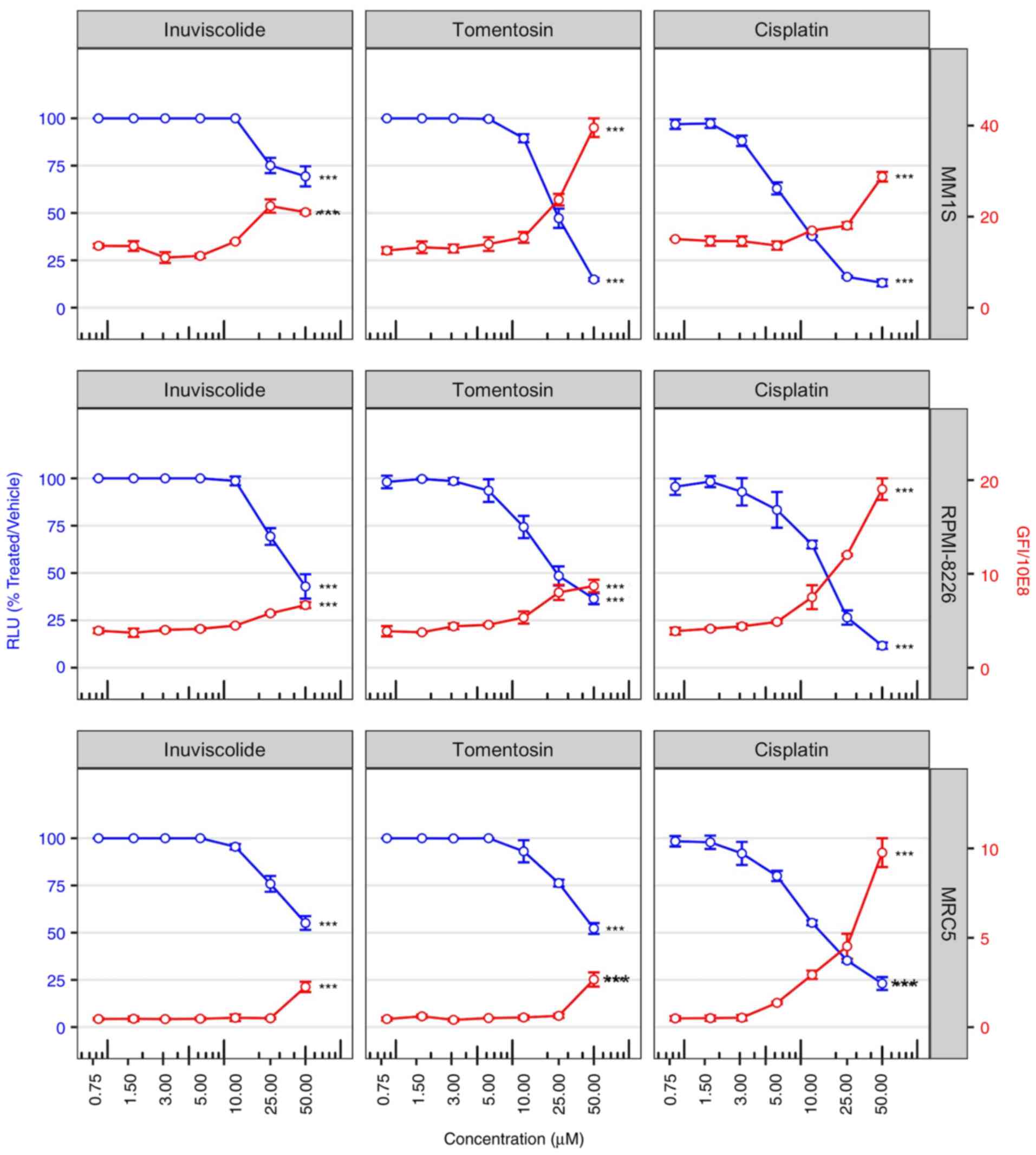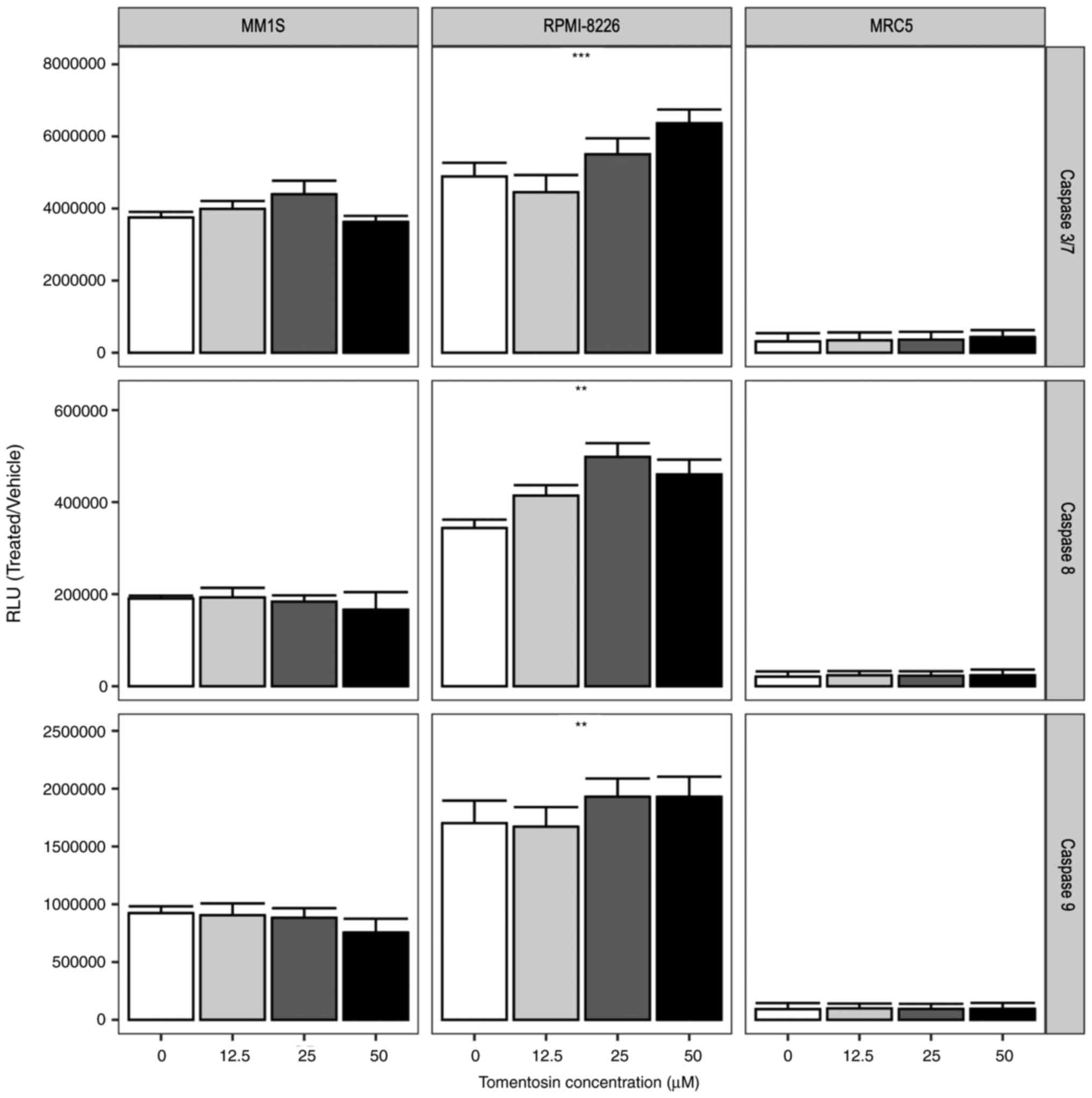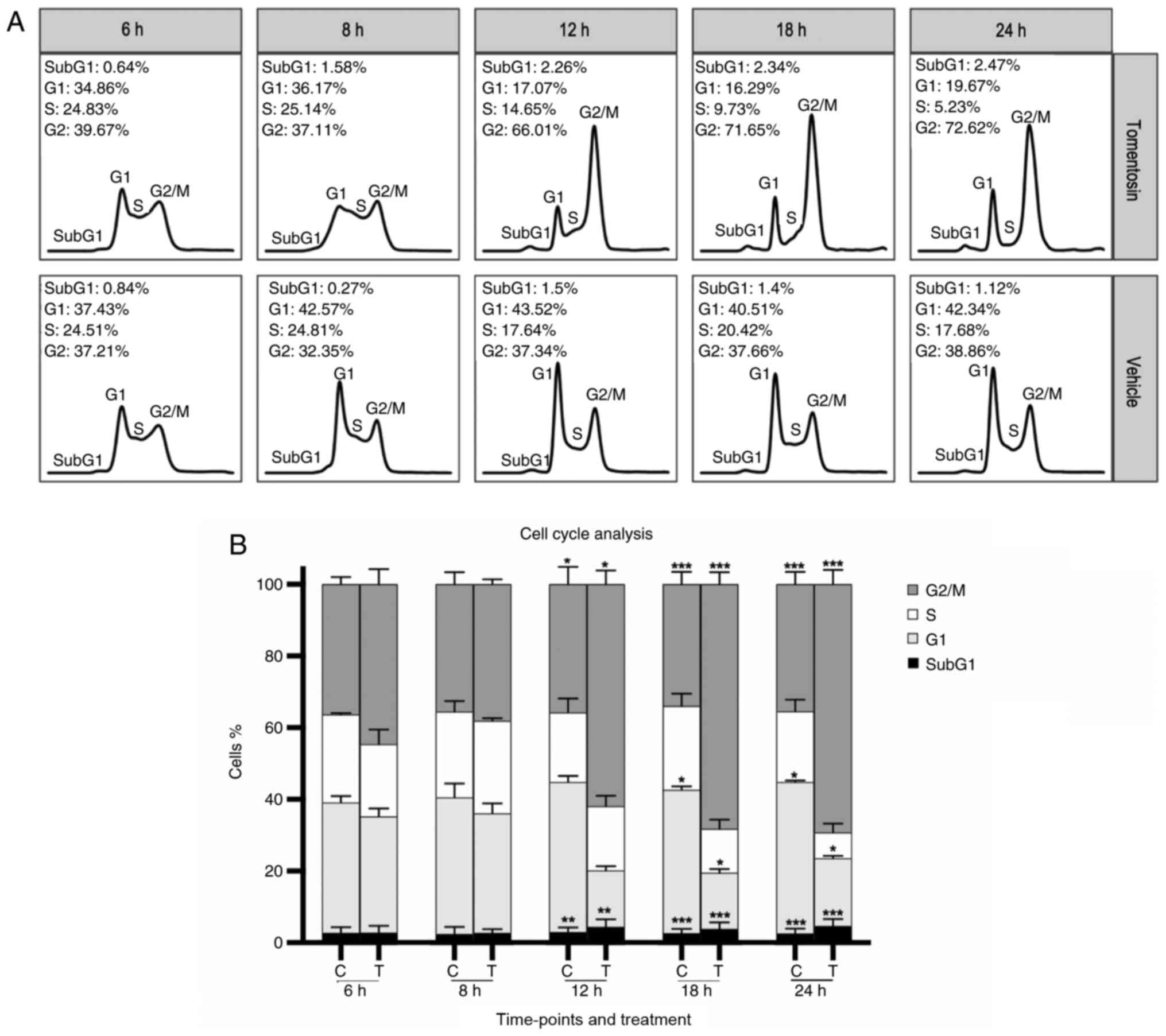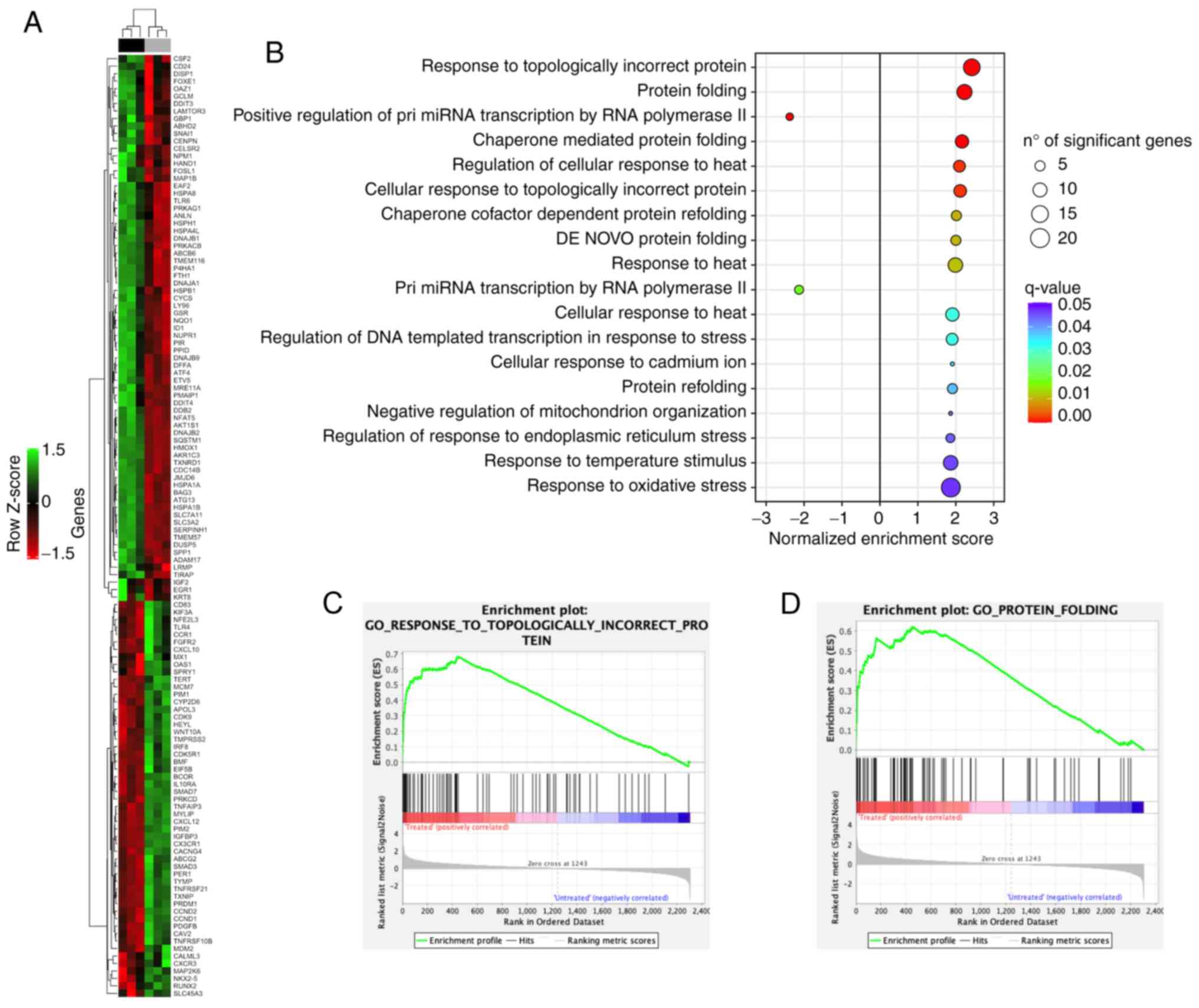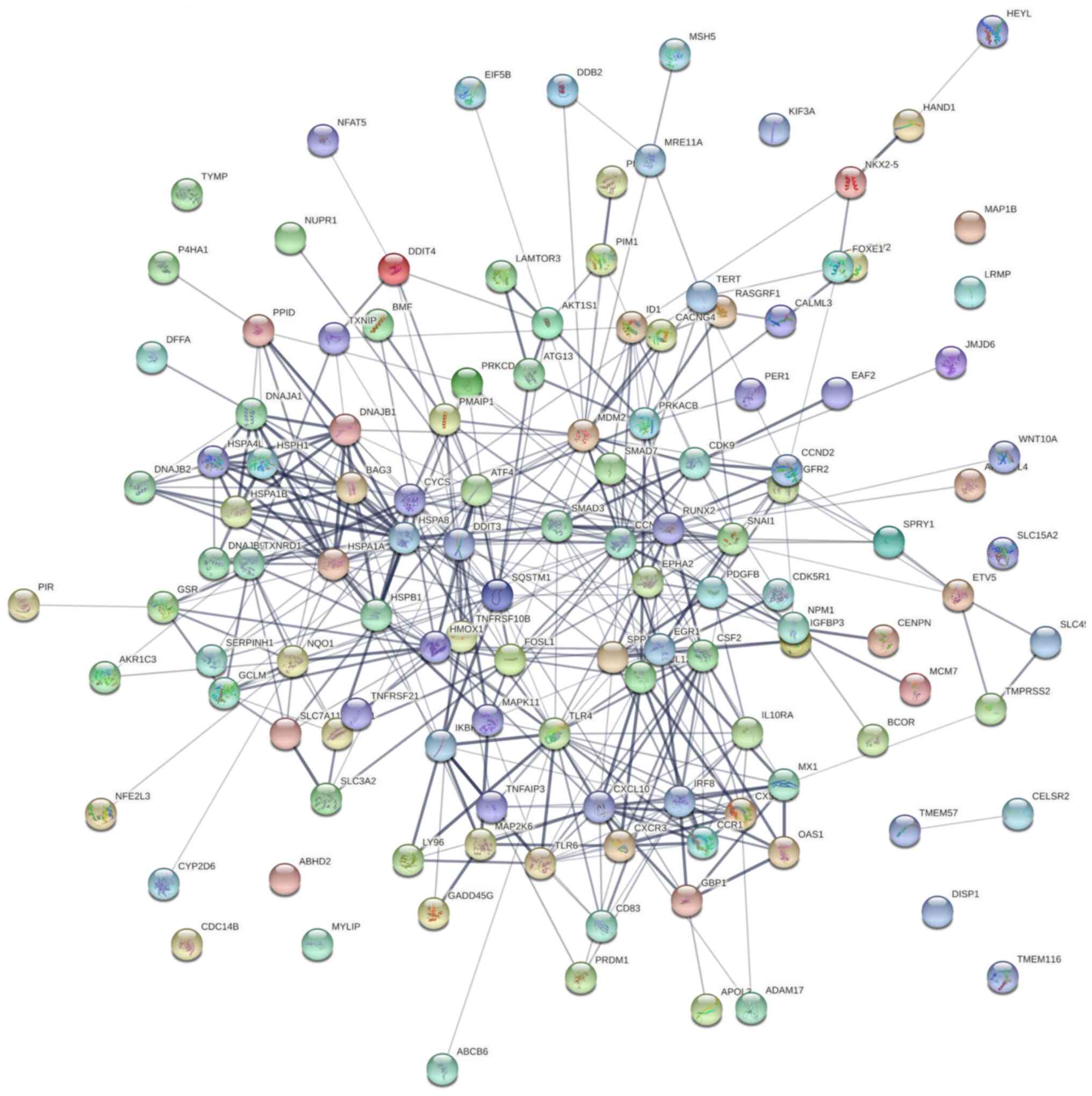|
1
|
Kumar SK, Dispenzieri A, Lacy MQ, Gertz
MA, Buadi FK, Pandey S, Kapoor P, Dingli D, Hayman SR, Leung N, et
al: Continued improvement in survival in multiple myeloma: Changes
in early mortality and outcomes in older patients. Leukemia.
28:1122–1128. 2014. View Article : Google Scholar :
|
|
2
|
Röllig C, Knop S and Bornhäuser M:
Multiple myeloma. Lancet. 385:2197–2208. 2015. View Article : Google Scholar
|
|
3
|
van de Donk NWCJ, Pawlyn C and Yong KL:
Multiple myeloma. Lancet. 397:410–427. 2021. View Article : Google Scholar : PubMed/NCBI
|
|
4
|
Kyle RA and Rajkumar SV: Drug therapy:
Multiple myeloma. N Engl J Med. 351:1860–1873. 2004. View Article : Google Scholar : PubMed/NCBI
|
|
5
|
Roodman GD: Pathogenesis of myeloma bone
disease. Leukemia. 23:435–441. 2009. View Article : Google Scholar
|
|
6
|
Raje NS, Bhatta S and Terpos E: Role of
the RANK/RANKL pathway in multiple myeloma. Clin Cancer Res.
25:12–20. 2019. View Article : Google Scholar
|
|
7
|
Kyle RA, Child JA, Anderson K, Barlogie B,
Bataille R, Bensinger W, Bladé J, Boccadoro M, Dalton W, Dimopoulos
M, et al: Criteria for the classification of monoclonal
gammopathies, multiple myeloma and related disorders: A report of
the international myeloma working group. Br J Haematol.
121:749–757. 2003. View Article : Google Scholar
|
|
8
|
Maiese EM, Evans KA, Chu BC and Irwin DE:
Temporal trends in survival and healthcare costs in patients with
multiple myeloma in the United States. Am Heal Drug Benefits.
11:39–46. 2018.
|
|
9
|
Fonseca R, Abouzaid S, Bonafede M, Cai Q,
Parikh K, Cosler L and Richardson P: Trends in overall survival and
costs of multiple myeloma, 2000-2014. Leukemia. 31:1915–1921. 2017.
View Article : Google Scholar :
|
|
10
|
Durie BGM, Hoering A, Abidi MH, Rajkumar
SV, Epstein J, Kahanic SP, Thakuri M, Reu F, Reynolds CM, Sexton R,
et al: Bortezomib with lenalidomide and dexamethasone versus
lenalidomide and dexamethasone alone in patients with newly
diagnosed myeloma without intent for immediate autologous stem-cell
transplant (SWOG S0777): A randomised, open-label, phase 3 trial.
Lancet. 389:519–527. 2017. View Article : Google Scholar :
|
|
11
|
Child JA, Morgan GJ, Davies FE, Owen RG,
Bell SE, Hawkins K, Brown J, Drayson MT and Selby PJ; Medical
Research Council Adult Leukaemia Working Party: High-dose
chemotherapy with hematopoietic stem-cell rescue for multiple
myeloma. N Engl J Med. 348:1875–1883. 2003. View Article : Google Scholar : PubMed/NCBI
|
|
12
|
McCarthy PL, Holstein SA, Petrucci MT,
Richardson PG, Hulin C, Tosi P, Bringhen S, Musto P, Anderson KC,
Caillot D, et al: Lenalidomide maintenance after autologous
stem-cell transplantation in newly diagnosed multiple myeloma: A
meta-analysis. J Clin Oncol. 35:3279–3289. 2017. View Article : Google Scholar : PubMed/NCBI
|
|
13
|
Bergsagel PL: Where we were, where we are,
where we are going: Progress in multiple myeloma. Am Soc Clin Oncol
Educ Book:. 199:–203. 2014.
|
|
14
|
Teoh PJ and Chng WJ: CAR T-cell therapy in
multiple myeloma: More room for improvement. Blood Cancer J.
11:842021. View Article : Google Scholar : PubMed/NCBI
|
|
15
|
Ludwig H, Delforge M, Facon T, Einsele H,
Gay F, Moreau P, Avet-Loiseau H, Boccadoro M, Hajek R, Mohty M, et
al: Prevention and management of adverse events of novel agents in
multiple myeloma: A consensus of the European myeloma network.
Leukemia. 32:1542–1560. 2018. View Article : Google Scholar : PubMed/NCBI
|
|
16
|
Pulte D, Redaniel MT, Brenner H, Jansen L
and Jeffreys M: Recent improvement in survival of patients with
multiple myeloma: Variation by ethnicity. Leuk Lymphoma.
55:1083–1089. 2014. View Article : Google Scholar
|
|
17
|
Kristinsson SY, Anderson WF and Landgren
O: Improved long-term survival in multiple myeloma up to the age of
80 years. Leukemia. 28:1346–1348. 2014. View Article : Google Scholar : PubMed/NCBI
|
|
18
|
Giuliani N, Accardi F, Marchica V, Dalla
Palma B, Storti P, Toscani D, Vicario E and Malavasi F: Novel
targets for the treatment of relapsing multiple myeloma. Expert Rev
Hematol. 12:481–496. 2019. View Article : Google Scholar : PubMed/NCBI
|
|
19
|
Virdis P, Migheli R, Galleri G, Fancello
S, Cadoni MPL, Pintore G, Petretto GL, Marchesi I, Fiorentino FP,
di Francesco A, et al: Antiproliferative and proapoptotic effects
of Inula viscosa extract on Burkitt lymphoma cell line. Tumor Biol.
42:10104283199010612020. View Article : Google Scholar
|
|
20
|
Barbetti P, Chiappini I, Fardella G and
Menghini A: A new eudesmane acid from Dittrichia (Inula) viscosa.
Planta Med. 51:4711985. View Article : Google Scholar : PubMed/NCBI
|
|
21
|
Lauro L and Rolih C: Observations and
research on an extract of Inula viscosa Ait. Boll Soc Ital Biol
Sper. 66:829–834. 1990.In Italian. PubMed/NCBI
|
|
22
|
Lev E and Amar Z: Ethnopharmacological
survey of traditional drugs sold in Israel at the end of the 20th
century. J Ethnopharmacol. 72:191–205. 2000. View Article : Google Scholar : PubMed/NCBI
|
|
23
|
Yaniv Z, Dafni A, Friedman J and Palevitch
D: Plants used for the treatment of diabetes in Israel. J
Ethnopharmacol. 19:145–151. 1987. View Article : Google Scholar : PubMed/NCBI
|
|
24
|
Al-Qura'n S: Ethnopharmacological survey
of wild medicinal plants in Showbak, Jordan. J Ethnopharmacol.
123:45–50. 2009. View Article : Google Scholar : PubMed/NCBI
|
|
25
|
Messaoudi M, Chahmi N, El-Mzibri M, Gmouh
S, Amzazi S, Benbacer L and El-Hassouni M: Cytotoxic Effect and
chemical composition of Inula viscosa from three different regions
of morocco. Eur J Med Plants. 16:1–9. 2016. View Article : Google Scholar
|
|
26
|
Rozenblat S, Grossman S, Bergman M,
Gottlieb H, Cohen Y and Dovrat S: Induction of G2/M arrest and
apoptosis by sesquiterpene lactones in human melanoma cell lines.
Biochem Pharmacol. 75:369–382. 2008. View Article : Google Scholar
|
|
27
|
Yang H, Zhao H, Dong X, Yang Z and Chang
W: Tomentosin induces apoptotic pathway by blocking inflammatory
mediators via modulation of cell proteins in AGS gastric cancer
cell line. J Biochem Mol Toxicol. 34:e225012020. View Article : Google Scholar : PubMed/NCBI
|
|
28
|
Merghoub N, El Btaouri H, Benbacer L,
Gmouh S, Trentesaux C, Brassart B, Attaleb M, Madoulet C, Wenner T,
Amzazi S, et al: Tomentosin induces telomere shortening and
caspase-dependant apoptosis in cervical cancer cells. J Cell
Biochem. 118:1689–1698. 2017. View Article : Google Scholar
|
|
29
|
Lee CM, Lee J, Nam MJ, Choi YS and Park
SH: Tomentosin displays anti-carcinogenic effect in human
osteosarcoma MG-63 cells via the induction of intracellular
reactive oxygen species. Int J Mol Sci. 20:15082019. View Article : Google Scholar :
|
|
30
|
Ihaka R and Gentleman R: R: A language for
data analysis and graphics. J Comput Graph Stat. 5:299–314.
1996.
|
|
31
|
Ellis B, Gentleman R, Hahne F, Le Meur N,
Sarkar D and Jiang M: flowViz: Visualization for flow cytometry. R
package version 1.56.0. 2021, https://www.bioconductor.org/packages/release/bioc/html/flowViz.html.
|
|
32
|
Love MI, Huber W and Anders S: Moderated
estimation of fold change and dispersion for RNA-seq data with
DESeq2. Genome Biol. 15:5502014. View Article : Google Scholar : PubMed/NCBI
|
|
33
|
Subramanian A, Tamayo P, Mootha VK,
Mukherjee S, Ebert BL, Gillette MA, Paulovich A, Pomeroy SL, Golub
TR, Lander ES and Mesirov JP: Gene set enrichment analysis: A
knowledge-based approach for interpreting genome-wide expression
profiles. Proc Natl Acad Sci USA. 102:15545–15550. 2005. View Article : Google Scholar : PubMed/NCBI
|
|
34
|
Ashburner M, Ball CA, Blake JA, Botstein
D, Butler H, Cherry JM, Davis AP, Dolinski K, Dwight SS, Eppig JT,
et al: Gene ontology: Tool for the unification of biology. The gene
ontology consortium Nat Genet. 25:25–29. 2000.
|
|
35
|
Carbon S, Douglass E, Good BM, Unni DR,
Harris NL, Mungall CJ, Basu S and Elser J: The gene ontology
resource: Enriching a GOld mine. Nucleic Acids Res. 49D:D325–D334.
2021.
|
|
36
|
Kanehisa M and Goto S: KEGG: Kyoto
encyclopedia of genes and genomes. Nucleic Acids Res. 28:27–30.
2000. View Article : Google Scholar
|
|
37
|
Igney FH and Krammer PH: Death and
anti-death: Tumour resistance to apoptosis. Nat Rev Cancer.
2:277–288. 2002. View
Article : Google Scholar : PubMed/NCBI
|
|
38
|
Costa LJ, Brill IK, Omel J, Godby K, Kumar
SK and Brown EE: Recent trends in multiple myeloma incidence and
survival by age, race, and ethnicity in the United States. Blood
Adv. 1:282–287. 2017. View Article : Google Scholar
|
|
39
|
Cavo M, Tacchetti P, Patriarca F, Petrucci
MT, Pantani L, Galli M, Di Raimondo F, Crippa C, Zamagni E, Palumbo
A, et al: Bortezomib with thalidomide plus dexamethasone compared
with thalidomide plus dexamethasone as induction therapy before,
and consolidation therapy after, double autologous stem-cell
transplantation in newly diagnosed multiple myeloma: A randomised 3
study. Lancet. 376:2075–2085. 2010. View Article : Google Scholar : PubMed/NCBI
|
|
40
|
Miguel JS, Weisel K, Moreau P, Lacy M,
Song K, Delforge M, Karlin L, Goldschmidt H, Banos A, Oriol A, et
al: Pomalidomide plus low-dose dexamethasone versus high-dose
dexamethasone alone for patients with relapsed and refractory
multiple myeloma (MM-003): A randomised, open-label, phase 3 trial.
Lancet Oncol. 14:1055–1066. 2013. View Article : Google Scholar : PubMed/NCBI
|
|
41
|
Singhal S, Mehta J, Desikan R, Ayers D,
Roberson P, Eddlemon P, Munshi N, Anaissie E, Wilson C, Dhodapkar
M, et al: Antitumor activity of thalidomide in refractory multiple
myeloma. N Engl J Med. 341:1565–1571. 1999. View Article : Google Scholar : PubMed/NCBI
|
|
42
|
Palumbo A, Hajek R, Delforge M, Kropff M,
Petrucci MT, Catalano J, Gisslinger H, Wiktor-Jędrzejczak W,
Zodelava M, Weisel K, et al: Continuous lenalidomide treatment for
newly diagnosed multiple myeloma. N Engl J Med. 366:1759–1769.
2012. View Article : Google Scholar : PubMed/NCBI
|
|
43
|
Dimopoulos M, Spencer A, Attal M, Prince
HM, Harousseau JL, Dmoszynska A, San Miguel J, Hellmann A, Facon T,
Foà R, et al: Lenalidomide plus dexamethasone for relapsed or
refractory multiple myeloma. N Engl J Med. 357:2123–2132. 2007.
View Article : Google Scholar : PubMed/NCBI
|
|
44
|
Drexler HG and MacLeod RAF: Malignant
hematopoietic cell lines: In vitro models for the study of
plasmacytoid dendritic cell leukemia. Leuk Res. 33:1166–1169. 2009.
View Article : Google Scholar : PubMed/NCBI
|
|
45
|
Yang L, Xie J, Almoallim HS, Alharbi SA
and Chen Y: Tomentosin inhibits cell proliferation and induces
apoptosis in MOLT-4 leukemia cancer cells through the inhibition of
mTOR/PI3K/Akt signaling pathway. J Biochem Mol Toxicol.
35:e227192021. View Article : Google Scholar : PubMed/NCBI
|
|
46
|
El Yaagoubi OM, Lahmadi A, Bouyahya A,
Filali H, Samaki H, El Antri S and Aboudkhil S: Antitumor effect of
Inula viscosa extracts on DMBA-induced skin carcinoma are mediated
by proteasome inhibition. Biomed Res Int. 2021:66875892021.
View Article : Google Scholar :
|
|
47
|
Zeissig MN, Hewett DR, Panagopoulos V,
Mrozik KM, To LB, Croucher PI, Zannettino ACW and Vandyke K:
Expression of the chemokine receptor CCR1 promotes the
dissemination of multiple myeloma plasma cells in vivo.
Haematologica. Nov 5–2020.Epub ahead of print. View Article : Google Scholar
|
|
48
|
Dairaghi DJ, Oyajobi BO, Gupta A,
McCluskey B, Miao S, Powers JP, Seitz LC, Wang Y, Zeng Y, Zhang P,
et al: CCR1 blockade reduces tumor burden and osteolysis in vivo in
a mouse model of myeloma bone disease. Blood. 120:1449–1457. 2012.
View Article : Google Scholar : PubMed/NCBI
|
|
49
|
Ganghammer S, Gutjahr J, Hutterer E, Krenn
PW, Pucher S, Zelle-Rieser C, Jöhrer K, Wijtmans M, Leurs R, Smit
MJ, et al: Combined CXCR3/CXCR4 measurements are of high prognostic
value in chronic lymphocytic leukemia due to negative
co-operativity of the receptors. Haematologica. 101:e99–e102. 2016.
View Article : Google Scholar :
|
|
50
|
Mulligan AM, Raitman I, Feeley L,
Pinnaduwage D, Nguyen LT, O'Malley FP, Ohashi PS and Andrulis IL:
Tumoral lymphocytic infiltration and expression of the chemokine
CXCL10 in breast cancers from the ontario familial breast cancer
registry. Clin Cancer Res. 19:336–346. 2013. View Article : Google Scholar :
|
|
51
|
Bolomsky A, Schreder M, Hübl W, Zojer N,
Hilbe W and Ludwig H: Monokine induced by interferon gamma
(MIG/CXCL9) is an independent prognostic factor in newly diagnosed
myeloma. Leuk Lymphoma. 57:2516–2525. 2016. View Article : Google Scholar : PubMed/NCBI
|
|
52
|
Guillerey C, Huntington ND and Smyth MJ:
Targeting natural killer cells in cancer immunotherapy. Nat
Immunol. 17:1025–1036. 2016. View Article : Google Scholar : PubMed/NCBI
|
|
53
|
Bonanni V, Antonangeli F, Santoni A and
Bernardini G: Targeting of CXCR3 improves anti-myeloma efficacy of
adoptively transferred activated natural killer cells. J Immunother
Cancer. 7:2902019. View Article : Google Scholar : PubMed/NCBI
|
|
54
|
Vijay K: Toll-like receptors in immunity
and inflammatory diseases: Past, present, and future. Int
Immunopharmacol. 59:391–412. 2018. View Article : Google Scholar : PubMed/NCBI
|
|
55
|
Chiron D, Bekeredjian-Ding I,
Pellat-Deceunynck C, Bataille R and Jego G: Toll-like receptors:
Lessons to learn from normal and malignant human B cells. Blood.
112:2205–2213. 2008. View Article : Google Scholar : PubMed/NCBI
|
|
56
|
Xu Y, Zhao Y, Huang H, Chen G, Wu X, Wang
Y, Chang W, Zhu Z, Feng Y and Wu D: Expression and function of
toll-like receptors in multiple myeloma patients: Toll-like
receptor ligands promote multiple myeloma cell growth and survival
via activation of nuclear factor-kappaB. Br J Haematol.
150:543–553. 2010. View Article : Google Scholar : PubMed/NCBI
|
|
57
|
Rossi D: Role of MYD88 in
lymphoplasmacytic lymphoma diagnosis and pathogenesis. Hematology
Am Soc Hematol Educ Program. 2014:113–118. 2014. View Article : Google Scholar
|
|
58
|
de Boussac H, Bruyer A, Jourdan M, Maes A,
Robert N, Gourzones C, Vincent L, Seckinger A, Cartron G, Hose D,
et al: Kinome expression profiling to target new therapeutic
avenues in multiple myeloma. Haematologica. 105:784–795. 2020.
View Article : Google Scholar :
|
|
59
|
Crawley JB, Williams LM, Mander T, Brennan
FM and Foxwell BMJ: Interleukin-10 stimulation of
phosphatidylinositol 3-kinase and p70 S6 kinase is required for the
proliferative but not the antiinflammatory effects of the cytokine.
J Biol Chem. 271:16357–16362. 1996. View Article : Google Scholar : PubMed/NCBI
|
|
60
|
Zhou JH, Broussard SR, Strle K, Freund GG,
Johnson RW, Dantzer R and Kelley KW: IL-10 inhibits apoptosis of
promyeloid cells by activating insulin receptor substrate-2 and
phosphatidylinositol 3′-kinase. J Immunol. 167:4436–4442. 2001.
View Article : Google Scholar : PubMed/NCBI
|
|
61
|
Zhan F, Huang Y, Colla S, Stewart JP,
Hanamura I, Gupta S, Epstein J, Yaccoby S, Sawyer J, Burington B,
et al: The molecular classification of multiple myeloma. Blood.
108:2020–2028. 2006. View Article : Google Scholar : PubMed/NCBI
|
|
62
|
Zhang PP, Wang YC, Cheng C, Zhang F, Ding
DZ and Chen DK: Runt-related transcription factor 2 influences cell
adhesion-mediated drug resistance and cell proliferation in B-cell
non-Hodgkin's lymphoma and multiple myeloma. Leuk Res. 92:106340Mar
9–2020. View Article : Google Scholar : PubMed/NCBI
|
|
63
|
Luo JH: Oncogenic activity of MCM7
transforming cluster. World J Clin Oncol. 2:120–124. 2011.
View Article : Google Scholar : PubMed/NCBI
|
|
64
|
Cortez D, Glick G and Elledge SJ:
Minichromosome maintenance proteins are direct targets of the ATM
and ATR checkpoint kinases. Proc Natl Acad Sci USA.
101:10078–10083. 2004. View Article : Google Scholar : PubMed/NCBI
|
|
65
|
Tsao CC, Geisen C and Abraham RT:
Interaction between human MCM7 and Rad17 proteins is required for
replication checkpoint signaling. EMBO J. 23:4660–4669. 2004.
View Article : Google Scholar : PubMed/NCBI
|
|
66
|
Tian L, Liu J, Xia GH and Chen BA:
RNAi-mediated knockdown of MCM7 gene on CML cells and its
therapeutic potential for leukemia. Med Oncol. 34:212017.
View Article : Google Scholar : PubMed/NCBI
|
|
67
|
Moll UM and Petrenko O: The MDM2-p53
interaction. Mol Cancer Res. 1:1001–1008. 2003.
|
|
68
|
Vassilev LT, Vu BT, Graves B, Carvajal D,
Podlaski F, Filipovic Z, Kong N, Kammlott U, Lukacs C, Klein C, et
al: In vivo activation of the p53 pathway by small-molecule
antagonists of MDM2. Science. 303:844–848. 2004. View Article : Google Scholar : PubMed/NCBI
|
|
69
|
Teoh PJ, Chung TH, Sebastian S, Choo SN,
Yan J, Ng SB, Fonseca R and Chng WJ: P53 haploinsufficiency and
functional abnormalities in multiple myeloma. Leukemia.
28:2066–2074. 2014. View Article : Google Scholar : PubMed/NCBI
|
|
70
|
Saha MN, Qiu L and Chang H: Targeting p53
by small molecules in hematological malignancies. J Hematol Oncol.
6:232013. View Article : Google Scholar : PubMed/NCBI
|
|
71
|
Teoh PJ and Chng WJ: P53 abnormalities and
potential therapeutic targeting in multiple myeloma. Biomed Res
Int. 2014:7179192014. View Article : Google Scholar : PubMed/NCBI
|
|
72
|
Halder SK, Beauchamp RD and Datta PK:
Smad7 induces tumorigenicity by blocking TGF-beta-induced growth
inhibition and apoptosis. Exp Cell Res. 307:231–246. 2005.
View Article : Google Scholar : PubMed/NCBI
|
|
73
|
Chen R, Wierda WG, Chubb S, Hawtin RE, Fox
JA, Keating MJ, Gandhi V and Plunkett W: Mechanism of action of
SNS-032, a novel cyclin-dependent kinase inhibitor, in chronic
lymphocytic leukemia. Blood. 113:4637–4645. 2009. View Article : Google Scholar : PubMed/NCBI
|
|
74
|
Czudor Z, Balogh M, Bánhegyi P, Boros S,
Breza N, Dobos J, Fábián M, Horváth Z, Illyés E, Markó P, et al:
Novel compounds with potent CDK9 inhibitory activity for the
treatment of myeloma. Bioorganic Med Chem Lett. 28:769–773. 2018.
View Article : Google Scholar
|
|
75
|
Hartl FU: Molecular chaperones in cellular
protein folding. Nature. 381:571–580. 1996. View Article : Google Scholar : PubMed/NCBI
|
|
76
|
Muralidharan S and Mandrekar P: Cellular
stress response and innate immune signaling: Integrating pathways
in host defense and inflammation. J Leukoc Biol. 94:1167–1184.
2013. View Article : Google Scholar : PubMed/NCBI
|
|
77
|
Chatterjee M, Andrulis M, Stühmer T,
Müller E, Hofmann C, Steinbrunn T, Heimberger T, Schraud H,
Kressmann S, Einsele H and Bargou RC: The PI3K/Akt signaling
pathway regulates the expression of Hsp70, which critically
contributes to Hsp90-chaperone function and tumor cell survival in
multiple myeloma. Haematologica. 98:1132–1141. 2013. View Article : Google Scholar :
|
|
78
|
Zhang L, Fok JJL, Mirabella F, Aronson LI,
Fryer RA, Workman P, Morgan GJ and Davies FE: Hsp70 inhibition
induces myeloma cell death via the intracellular accumulation of
immunoglobulin and the generation of proteotoxic stress. Cancer
Lett. 339:49–59. 2013. View Article : Google Scholar : PubMed/NCBI
|
|
79
|
Braunstein MJ, Scott SS, Scott CM, Behrman
S, Walter P, Wipf P, Coplan JD, Chrico W, Joseph D, Brodsky JL and
Batuman O: Antimyeloma effects of the heat shock protein 70
molecular chaperone inhibitor MAL3-101. J Oncol. 2011:2320372011.
View Article : Google Scholar : PubMed/NCBI
|
|
80
|
Workman P and Davies FE: A stressful life
(or death): Combinatorial proteotoxic approaches to
cancer-selective therapeutic vulnerability. Oncotarget. 2:277–280.
2011. View Article : Google Scholar : PubMed/NCBI
|
|
81
|
Tiku V, Tan MW and Dikic I: Mitochondrial
functions in infection and immunity: (Trends in Cell Biology 30,
263-275, 2020). Trends Cell Biol. 30:7482020. View Article : Google Scholar : PubMed/NCBI
|















